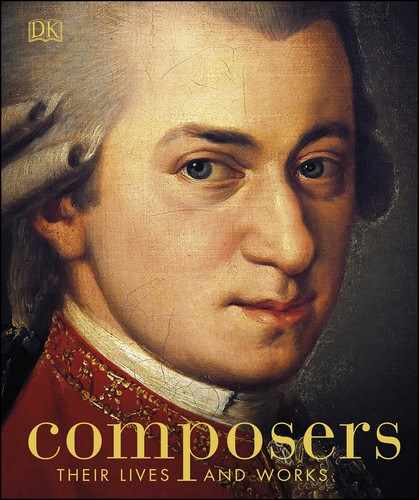Thomas Tallis
c. 1505–1585, ENGLISH
Tallis was a leading composer of church music during the Tudor period. He steered a difficult course through the Reformation, but maintained his status as a distinguished member of the Chapel Royal.

THOMAS TALLIS
Tallis, the foremost composer of English choral music in the 16th century, worked for both Catholics and Protestants during the Reformation. As a member of the Chapel Royal (an institution rather than a building), he wrote music that met the changing spiritual needs of the royal family. Tallis is depicted here in a stained-glass window at St. Alfege Church at Greenwich in London.
IN CONTEXT
The Dissolution of the Monasteries
By the Act of Supremacy (1534), Henry VIII became head of the Church of England, gaining complete authority over it. Two years later, his chief minister, Thomas Cromwell, began the process of suppressing religious houses—monasteries, convents, and priories—seizing all their assets for the Crown. Waltham Abbey was the last to be suppressed, in March 1540. This policy had serious consequences for English musicians—many lost both their home and their livelihood. Countless musical manuscripts were also lost when the monastic libraries were sold off or even destroyed.

WALTHAM ABBEY, ESSEX, ENGLAND

HENRY VIII
England’s Tudor king (reigned 1509–1547) imposed a series of repressive measures on religious houses that had a grave impact on the welfare of some musicians.
Little is known about Thomas Tallis’s early life. There are claims that he came from Leicestershire or Kent, but the first known record dates from 1532, when he was an organist at Dover Priory. By 1537, Tallis had moved to the parish church of St. Mary-at-Hill in London. A year later, he transferred to Waltham Abbey, outside the capital.
This was probably a shrewd move. Religious houses were already being suppressed as part of Henry VIII’s plan to take control of the Church of England, but the severance pay was generous. When Waltham was dissolved in 1540, Tallis received 20 shillings in back-pay and a further 20 shillings “reward.”
The Chapel Royal
For many journeyman musicians, the Dissolution of the Monasteries was a disaster (see box), but Tallis’s talent and ambition helped secure his future. He soon found another job, as one of the “singing men” at Canterbury Cathedral. Two years later, in 1543, he landed his dream job in the Chapel Royal—an elite group of clergy and musicians attached to the royal household, who played wherever the monarch required. For a composer of sacred music, this was the absolute pinnacle of the profession—a secure, well-paid job, working with the finest musicians. Not surprisingly, Tallis remained with the group until he retired.
Change and adaptation
The composer’s greatest asset was his adaptability as he negotiated the tumultuous changes during the Reformation: services were held in English rather than Latin; and the chantries—where “soul-priests” sang Masses for the dead—were abolished, along with special services on saints’ feast-days. There was less music and it was more direct and simple. Elaborate polyphony was replaced by greater emphasis on psalms and anthems. Yet these changes were not permanent. Catholicism was revived during the reigns of Edward VI (1547–1553) and Mary (1553–1558), before Protestantism returned under Elizabeth I.
Tallis switched from one musical idiom to another with assurance. Videte miraculum is a graceful, six-part antiphon for the Virgin Mary, while the anthem If ye love me is a fine example of his simpler “reformed” style.
Tallis’s masterpiece, however, is the monumental Spem in alium, a motet sung by eight five-part choirs arranged in a circle. The audience sits in the center, as the voices eddy back and forth around them. There was a rumor that Tallis composed this extraordinarily intricate piece in response to a challenge from the duke of Norfolk, but this cannot be verified.

SCORE OF CANTIONES SACRAE
In 1575, the composers Thomas Tallis and William Byrd together published, under special license, Cantiones sacrae (Sacred Songs). The cover of the original manuscript is shown here.
In his later years, Tallis worked with his pupil William Byrd. The pair were granted an exclusive license by Elizabeth I to print and sell music, and in 1575 they produced a book of motets, Cantiones sacrae (Sacred Songs).
